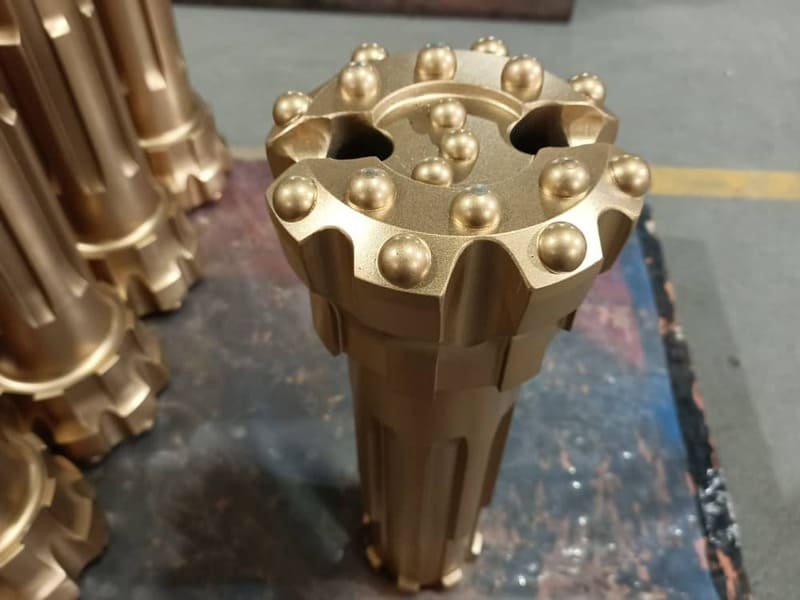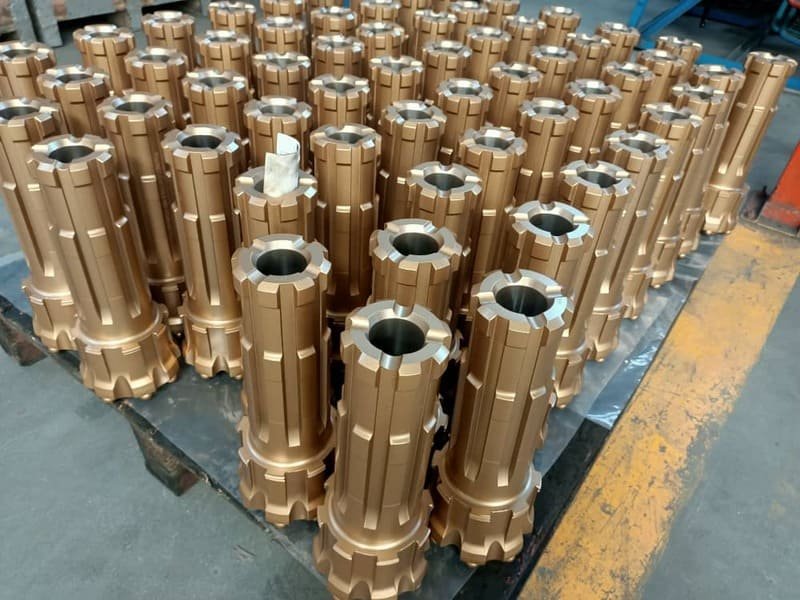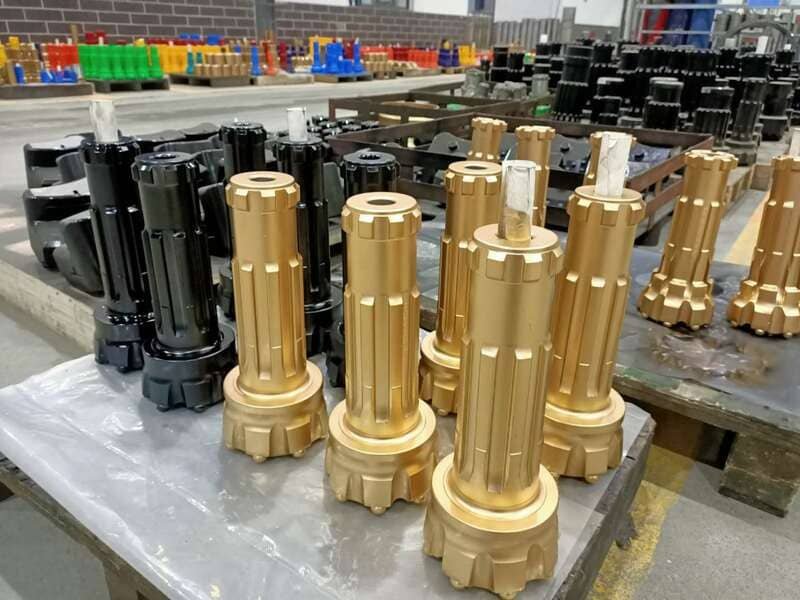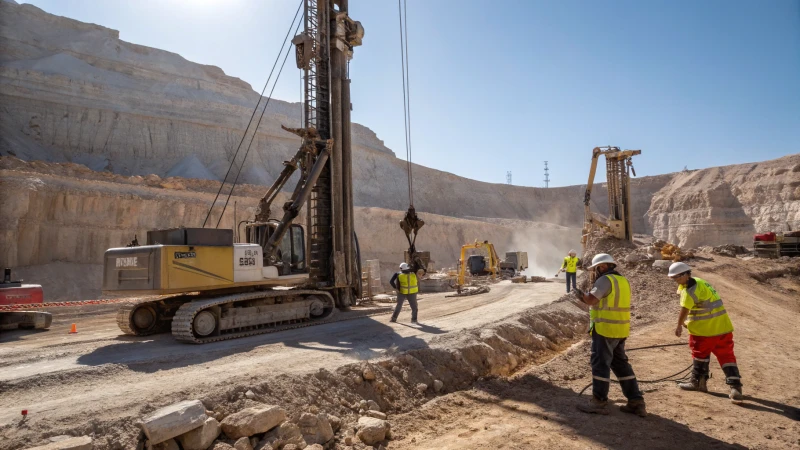Finding the right tools for deep drilling feels like assembling a jigsaw puzzle—you need each piece to fit perfectly for the big picture to work.
The best extended length options for deeper drilling include DTH drill bits with custom gauge lengths, extra-long drill bits tailored for specific tasks, and designs that enhance hole straightness and stability.
When I first ventured into deep drilling, I was overwhelmed by the choices. It felt like a high-stakes game where the wrong move could cost time and money. But, once I understood the nuances—like the importance of gauge lengths and stability—the path became clearer. Selecting the right tools is akin to choosing the right shoes for a marathon; they need to be sturdy and suited to the terrain.
Extra-long drill bits, for instance, have been game-changers in reaching hard-to-access areas. Their length offers precision in places where standard bits fall short. It's crucial to consider rock formation and drilling efficiency because these factors can dramatically impact project outcomes. So, each choice in this process is a step toward success.
Extra-long drill bits enhance hole straightness in deep drilling.True
Extra-long drill bits are designed for maintaining straightness in deep holes.
DTH drill bits are unsuitable for deep drilling projects.False
DTH drill bits are commonly used for deep drilling due to their efficiency.
How Do Gauge Length Variations Impact Drilling Efficiency?
Ever wondered how something as simple as the length of a drill bit can change the game in drilling operations?
Gauge length variations in drill bits impact drilling efficiency by affecting hole straightness, stability, and penetration rates. Longer gauges enhance alignment but may reduce drilling speed.

The Role of Gauge Length in Drilling
I've always been fascinated by how small adjustments can make a big difference, especially in drilling. Gauge length refers to the distance from the drill bit's cutting face to the outermost point of its gauge section. This might seem like a minor detail, but it plays a crucial role in drilling operations1, affecting both trajectory and precision.
-
Hole Straightness: I remember a project where maintaining straight holes was paramount. Longer gauge lengths were our go-to. They provided the guidance needed to prevent deviation, especially in deep drilling scenarios.
-
Stability and Control: Think of it like driving on a rocky road. Extended lengths improve the bit's stability, which is vital when working with challenging environments like hard rock formations. This stability translates into consistent performance and less wear on equipment.
Balancing Speed and Efficiency
Longer gauges have their perks—like better straightness and control—but they can slow down drilling speed. It's a classic trade-off between maintaining precision and achieving high penetration rates.
| Gauge Length | Advantages | Disadvantages |
|---|---|---|
| Short | Fast penetration rates | Less control over hole direction |
| Long | Better hole alignment and stability | Slower drilling speed |
Industry Applications
Different industries use gauge length variations for specific applications:
-
Mining2: Longer gauges were our heroes in exploratory drilling to reach deeper mineral seams accurately.
-
Oil and Gas: In oil exploration, those extended lengths maintain wellbore integrity over great depths—a lifesaver for us.
-
Geotechnical Surveys: When assessing soil stability, accurate hole straightness is crucial, often requiring custom gauge lengths.
Customization for Enhanced Performance
We often need to tailor our equipment to meet specific project needs. Manufacturers offer custom gauge lengths that optimize performance based on geological conditions, enhancing overall drilling efficiency.
- Extended Length Options: These are designed for deeper drills, providing enhanced straightness.
- Tailored Solutions: Custom gauges cater to unique project demands, ensuring maximum effectiveness3.
By grasping these variations, I've learned that operators can make informed decisions on equipment selection and strategies, leading to better outcomes across various drilling applications. It’s all about understanding what each project demands and adapting accordingly.
Longer gauge lengths improve hole straightness in drilling.True
Longer gauge lengths provide better guidance, maintaining straight holes.
Short gauge lengths offer better stability in hard rock formations.False
Short gauge lengths offer less control and stability in challenging environments.
What Are the Key Benefits of Using Extended Length Drill Bits?
Ever tried drilling a deep hole only to realize your standard bit just won’t cut it?
Extended length drill bits are a game-changer for reaching deeper, maintaining precise alignment, and offering extra stability in those hard-to-access spots. Perfect for projects needing accuracy beyond what standard bits can achieve, they’re essential for tackling challenging drilling tasks.

Deeper Reach and Versatility
I remember when I first started working on a construction project that required reaching into tight spaces. The frustration of not having the right tools was palpable. That's when I discovered the magic of extended length drill bits. These tools effortlessly access depths that standard bits simply can't, making them indispensable for tasks like geotechnical drilling4 where deep soil layers need exploration. In the construction industry, these bits have saved me countless hours by allowing precise work in awkward, hard-to-reach areas.
| Application | Benefit |
|---|---|
| Plumbing | Access tight spaces |
| Electrical installations | Reach conduits behind structures |
| HVAC systems | Drill through thick walls |
Improved Hole Straightness
Another revelation came during a particularly challenging mining operation5. The need for precise hole placement was critical, and longer drill bits were a lifesaver. They helped maintain alignment and straightness, reducing waste and boosting efficiency—a real win-win.
Enhanced Stability in Hard Materials
When dealing with tough materials like concrete or metal, stability is key. I’ve learned firsthand how extended length drill bits are engineered for this very purpose. Their ability to reduce vibrations and provide better control has been invaluable, especially in mining and quarrying6 where equipment longevity is a must.
Considerations When Using Extended Length Drill Bits
- Material Compatibility: It's crucial to match the drill bit with the substrate to avoid wear and tear.
- Rotational Speed: Adjust speeds wisely to prevent overheating with those longer lengths.
- Depth Measurement: Guides or depth stops are your best friends for accuracy in deep drilling.
By understanding these considerations, you can truly unlock the potential of extended length drill bits, optimizing both performance and lifespan across various industrial applications. Whether you're deep in the trenches or reaching for the sky, these tools are designed to meet—and exceed—your expectations.
Extended drill bits improve hole straightness.True
Longer bits maintain alignment, crucial for precise hole placement.
Extended drill bits are unsuitable for hard materials.False
They enhance stability, reducing vibrations in hard materials like concrete.
How to Choose the Right Extra-Long Drill Bits for Your Project?
Choosing the right extra-long drill bit can feel like solving a puzzle. When you're facing the challenge of drilling through thick materials or reaching those awkward spots, picking the correct bit is crucial for getting the job done right.
To select the right extra-long drill bits, consider material compatibility, length needs, and drilling conditions. Assess factors like hole depth and material hardness to ensure optimal performance and success in your project.

Understanding Drill Bit Material Compatibility
When I first tackled a project involving hard metals, I quickly learned that not all drill bits are created equal. For tough materials like these, carbide-tipped bits7 became my best friend due to their durability and heat resistance.
| Material Type | Recommended Bit Type |
|---|---|
| Wood | High-Speed Steel (HSS) |
| Metal | Cobalt or Carbide |
| Concrete/Masonry | Masonry Bits with Tungsten Carbide |
Evaluating Length Requirements
I remember a time when I underestimated the depth of a hole I needed to drill. Let's just say it was a lesson learned! Extra-long bits typically range from 12 to 18 inches, or even more. Make sure you measure your needs accurately and ensure the bit fits your drilling equipment8.
Analyzing Drilling Conditions
The environment plays a huge role in selecting the right drill bit. I once had to drill in a rocky area, and longer bits were essential for maintaining hole straightness and stability. Consider exploring gauge length variations9 to tailor bit performance to specific applications.
- Rock Formation: Tougher bits are necessary for harder formations.
- Hole Straightness: Longer bits help maintain straightness in deeper drilling.
- Drilling Speed: Balance length with speed to avoid reduced penetration rates.
Applications of Extra-Long Drill Bits
Extra-long bits have saved me more times than I can count in various projects:
- Geotechnical Drilling: Perfect for assessing soil stability with deep holes.
- Mining: Essential for reaching deeper seams during exploration or extraction.
- Oil and Gas Exploration: Critical for evaluating reserves at significant depths.
For unique needs, customized gauge lengths10 can enhance hole alignment and stability, ensuring efficiency across different geological settings. Every choice you make impacts your project's success, so choose wisely!
Carbide-tipped bits are best for hard metals.True
Carbide-tipped bits offer durability and heat resistance needed for hard metals.
HSS bits are suitable for concrete drilling.False
Masonry bits with tungsten carbide are recommended for concrete, not HSS.
What Factors Should You Consider for Effective Deep Drilling?
Deep drilling is like piecing together a puzzle—each factor is a vital piece for success. From choosing the right tools to understanding the lay of the land, every element counts.
Effective deep drilling hinges on selecting compatible equipment, understanding geological conditions, and employing the right drilling techniques. These factors help optimize performance, minimize downtime, and ensure precision in results.

Equipment Selection
Choosing the right equipment is like picking the perfect tool for a job. Imagine facing a rugged mountain—would you choose a gentle spade or a robust pickaxe? That's what it's like selecting drill bits and hammers. Depending on the geological conditions, a DTH11 hammer might be your best bet for tough rock, while softer terrains might call for top hammer drills.
Geological Conditions
Understanding the earth beneath is like reading a story written in stone. It’s about knowing the rock’s hardness, its abrasiveness, and where water might seep through. This knowledge guides your equipment choices and drilling methods. Geotechnical analysis reports can be your trusted guide in this rocky tale.
Drilling Technique
The technique you choose can change the game. It's like deciding whether to sprint or jog based on the terrain ahead. Rotary drilling might be your go-to for deep, fast operations, while percussion drilling could be ideal for shallower depths.
Table: Equipment and Technique Considerations
| Factor | Equipment | Technique |
|---|---|---|
| Rock Hardness | DTH Hammer | Percussion |
| Depth | Rotary Drill | Rotary |
| Abrasiveness | Custom Bits | Variable Speed |
Drilling Efficiency
Efficiency in drilling is about keeping everything running smoothly—like a well-oiled machine. You’ll want to keep an eye on penetration rates, torque, and vibrations. Advanced monitoring systems are like having a dashboard that keeps you informed in real-time.
Safety Measures
Safety in drilling is paramount. It’s not just about protecting equipment; it’s about people too. Regular safety training and audits ensure everyone goes home safe, and implementing safety protocols12 is key to preventing accidents and staying compliant with industry standards.
DTH hammers are ideal for soft rock formations.False
DTH hammers are best suited for hard rock due to their percussive force.
Rotary drilling is preferred for deeper operations.True
Rotary drilling offers speed and efficiency, making it ideal for deep operations.
Which Industries Find Extended Length Drill Bits Most Useful?
Ever found yourself needing to reach just a bit further, wishing you had the right tool?
Extended length drill bits shine in industries like construction, mining, oil and gas, and aerospace, where they ensure deep drilling with unmatched precision and stability, essential for complex projects.

Construction Industry
I remember the first time I watched a skyscraper being built; it was a marvel of engineering. Extended length drill bits play a crucial role here, especially when the task demands drilling deep into concrete or other tough materials. These bits make the job of installing deep anchors and rebar connections much more manageable. Contractors, like some of my colleagues, often rely on them to achieve precise depth13 when laying foundations or constructing towering buildings.
Mining and Quarrying
Mining is all about reaching those hidden treasures buried deep within the earth. I've spoken with miners who swear by extended length drill bits for their exploratory drilling missions. They tell me these bits are indispensable for reaching deeper ore deposits or seams, a necessity when assessing mineral presence or the economic viability of a site. They also provide superior hole alignment14 in tricky terrains.
| Industry | Usage |
|---|---|
| Construction | Deep anchors, rebar connections |
| Mining | Exploratory drilling, ore evaluation |
| Oil and Gas | Initial well drilling |
| Aerospace | Component assembly, precision drilling |
Oil and Gas Exploration
In the world of oil and gas, reaching those deeper reservoirs is key. I once chatted with an engineer who explained how these extended bits are essential during initial well drilling stages. They ensure we can evaluate potential reserves with high accuracy, avoiding costly delays by maintaining hole straightness.
Aerospace Industry
When it comes to aircraft, precision is non-negotiable. In the aerospace sector, extended length drill bits help achieve the precision needed for assembling components. I think of them as unsung heroes, ensuring every aircraft part meets structural integrity standards crucial for safety and performance. The need for precision15 really cannot be overstated.
Geotechnical Drilling
Then there's geotechnical drilling—a field where these bits are vital for soil sampling and analysis. Engineers use them to probe deeper layers of soil or rock, gathering data to assess stability for construction projects. This knowledge is indispensable for guaranteeing the safety of large-scale developments like bridges or dams.
Extended bits are vital for deep anchors in construction.True
In construction, extended bits help install deep anchors into concrete.
Aerospace industry rarely uses extended length drill bits.False
Aerospace relies on these bits for precision drilling in component assembly.
Conclusion
Explore the best extended length options for deep drilling, including DTH drill bits and custom gauge lengths, enhancing precision, stability, and efficiency across various industries.
-
Learn about gauge length in drilling to understand its importance in maintaining hole straightness and precision. ↩
-
Discover how gauge length impacts mining operations, specifically in exploratory drilling for deeper mineral seams. ↩
-
Explore how tailored gauge lengths improve drilling performance based on specific project needs. ↩
-
Explore how extended length drill bits enhance geotechnical drilling by improving depth access and precision. ↩
-
Learn why straight hole drilling is critical in mining operations and how extended length drill bits aid this. ↩
-
Discover how extended length drill bits enhance stability during mining and quarrying activities. ↩
-
Carbide-tipped bits are ideal for hard metals due to their durability and heat resistance, offering superior performance. ↩
-
Understanding equipment compatibility ensures that the chosen drill bits fit properly, preventing operational inefficiencies. ↩
-
Gauge length variations allow for customization, ensuring optimal drill bit performance tailored to project needs. ↩
-
Custom gauge lengths improve drilling accuracy and stability, especially in challenging geological conditions. ↩
-
Explore this link to understand why DTH hammers are advantageous for deep drilling in hard rock formations. ↩
-
Discover best practices for establishing safety measures in drilling operations to enhance worker protection. ↩
-
Learn techniques to achieve precise drilling depth, crucial for structural integrity in construction projects. ↩
-
Discover methods to enhance hole alignment during mining operations, essential for efficiency and safety. ↩
-
Understand why precision drilling is critical in aerospace, impacting component integrity and safety. ↩








